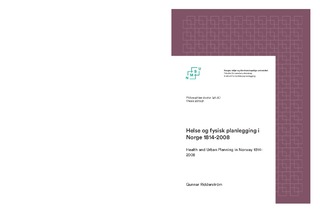| dc.contributor.advisor | Røsnes, August | |
| dc.contributor.advisor | Thorén, Kine Halvorsen | |
| dc.contributor.author | Ridderström, Gunnar | |
| dc.date.accessioned | 2017-12-04T13:11:51Z | |
| dc.date.available | 2017-12-04T13:11:51Z | |
| dc.date.issued | 2017-12-04 | |
| dc.identifier.isbn | 978-82-575-1274-3 | |
| dc.identifier.issn | 1894-6402 | |
| dc.identifier.uri | http://hdl.handle.net/11250/2469055 | |
| dc.description.abstract | Avhandlingen tar for seg hvordan byplanleggingen i Norge har vært benyttet i det forebyggende og helsefremmende arbeidet fra begynnelsen av 1800‐tallet og til plan- og bygningsloven i 2008. I avhandlingen analyseres helseforholdenes betydning og innflytelse på byplanlegging og samfunnsplanlegging. Formålet har vært å komme fram til en forståelse av hvordan helsemessige forhold i videste forstand har hatt innflytelse og betydning for byplanleggingen i ulike tidsperioder i Norge.
Det empiriske grunnlaget er bygningslovene med forarbeidene til Stortinget fra 1814 til og med 2008. Forarbeidene består av lovforslag, høringsuttalelser, komitébehandling i Stortinget, stortingsdebattene og de vedtatte lovene. I tillegg analyseres enkelte stortingsmeldinger og offentlige utredninger. Bygningslovgivningen analyseres ut fra tre perspektiver: Hvilken kunnskapen om helsen som ble lagt til grunn i lovarbeidet, hvilke normer for løsninger som var dominerende, og hvilke regler som lå til grunn for, og ble innarbeidet i, bygningslovene. | nb_NO |
| dc.description.abstract | To prevent disease was one of the reasons to formalize urban planning in Norway at the beginning of the 19th century. This Ph.D. analyses how urban planning in Norway has been used in the preventive medicine and health promotion from the beginning of the 19th century until 2008. The use of knowledge and arguments connected to health issues are analysed in order to
gain understanding as to how health issues has influenced the development of urban planning and design in Norway.
The empirical basis of the Ph.D. is the planning and building legislation in Norway between 1814 and 2008. This includes suggestions from experts, materials from public hearings, discussions and suggestions from committees in Stortinget (the Norwegian parliament), the discussions in
Stortinget and the passed legislation. The material is analysed from three perspectives: What
knowledge about health that was available, what norms that was predominant in the development of the legislation, and what rules that were used as the basis in the legislation. | nb_NO |
| dc.language.iso | nob | nb_NO |
| dc.publisher | Norwegian University of Life Sciences, Ås | |
| dc.relation.ispartofseries | PhD Thesis;2015:21 | |
| dc.subject | Health | nb_NO |
| dc.subject | Public health | nb_NO |
| dc.subject | Prevention | nb_NO |
| dc.subject | Promoting health | nb_NO |
| dc.subject | Urban planning | nb_NO |
| dc.subject | Land- use planning | nb_NO |
| dc.title | Helse og fysisk planlegging i Norge 1814-2008 | nb_NO |
| dc.title.alternative | Health and Urban Planning in Norway 1814-2008 | nb_NO |
| dc.type | Doctoral thesis | nb_NO |
| dc.source.pagenumber | 564 | nb_NO |
